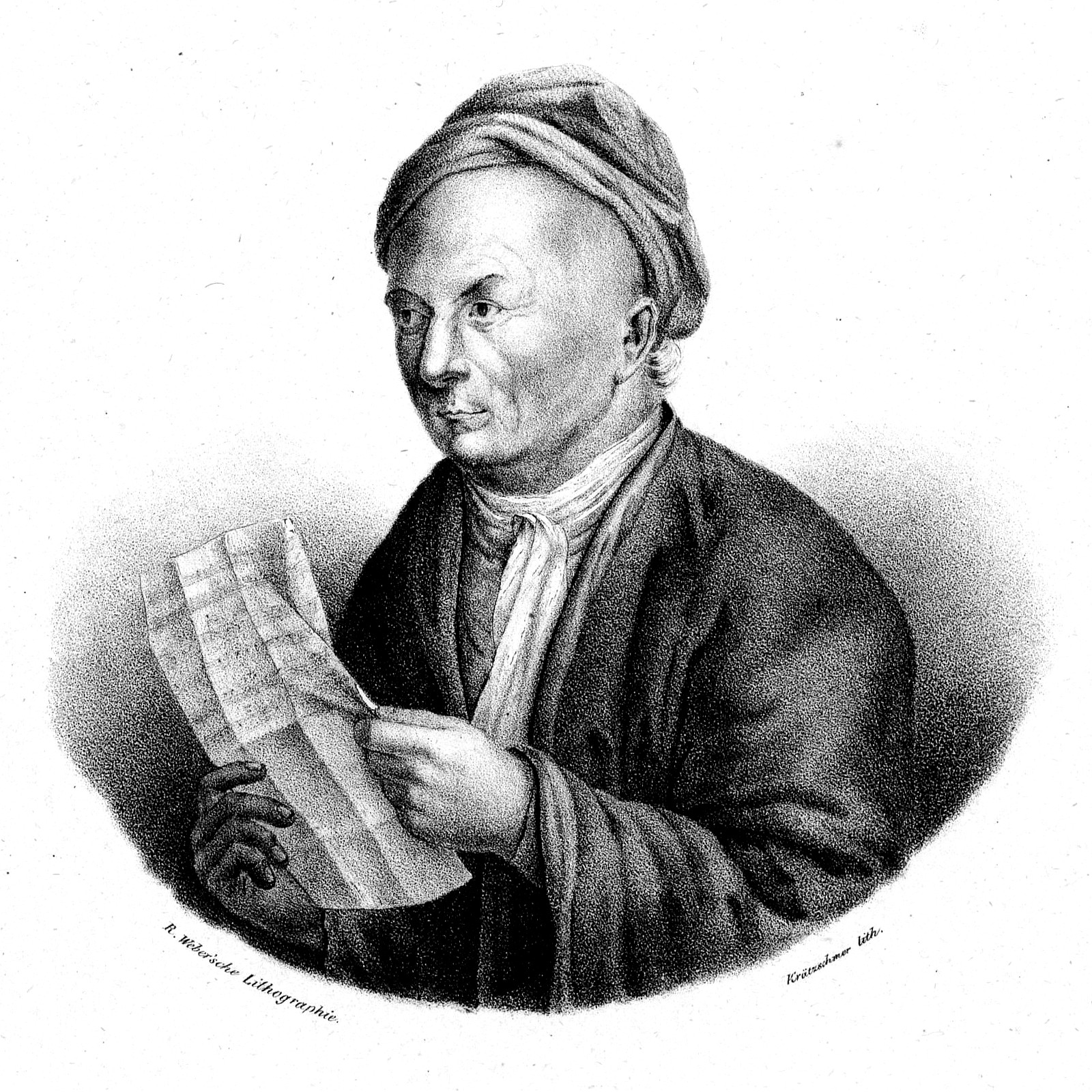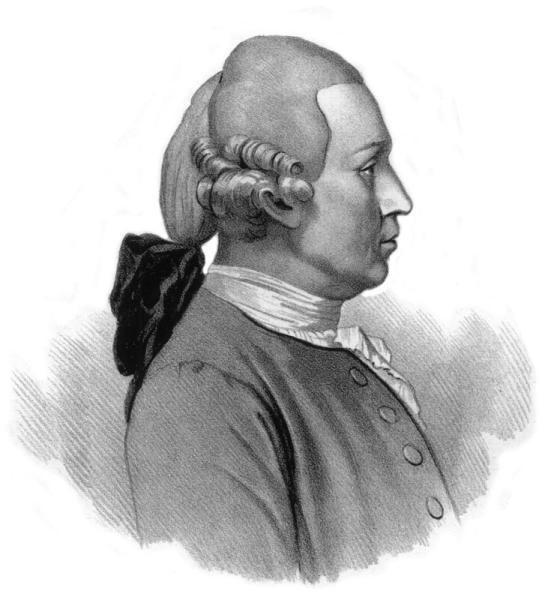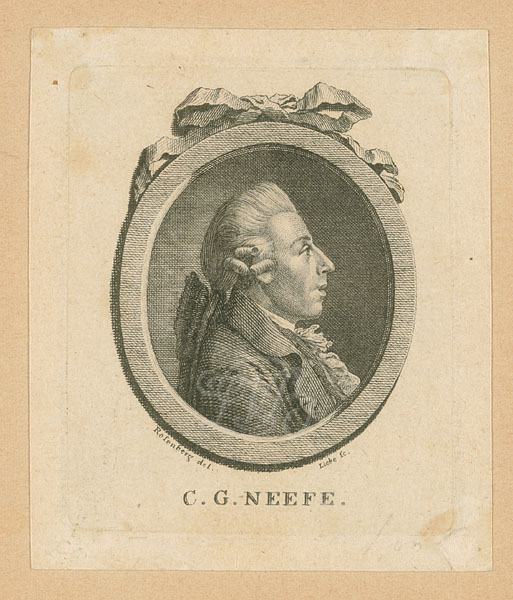Since many piano teachers and instructors often have many students, it's not hard to imagine that branching out from the famous pianists of history their lineage or succession of talented pupils and virtual "descendants." These pupils have spread out across the globe over the decades and can trace their musical education back to the masters of the Romantic era and perhaps further.
BACH, HOMILIUS, HILLER AND NEEFE
We will examine one such lineage leading up to the present day beginning with none other than Johann Sebastian Bach. Much has been written about this master who was composing and performing when the piano was in its infancy and therefore concentrated on the organ, clavichord and harpsichord.
J.S. Bach's pupil Gottfried August Homilius (at left) was born in 1714 in Rosenthal. He studied law at the University of Leipzig starting in 1735. During this time he studied privately with Bach at least until 1742 when he put the world of law behind him to some extent to become the organist of the Frauenkirche (Cathedral of Our Dear Lady) in Dresden. 13 years later he worked in Dresden's three primary churches as the director of music as well as the choir master of the Kreuzschule (Church of the Cross).He was highly regarded as an organist and composer. He died in Dresden in 1785.
Speaking of the Kreuzschule, it is the oldest surviving school in Dresden; possibly founded in the 14th century. This is where Homilius taught his pupil Johann Adam Hiller.
Hiller (at left) was born on Christmas Day, 1728 in Wendlich-Ossig, Germany. After his father's death at age 6 he found it difficult to procure a proper musical education. He persisted however with his talents in several instruments as well as voice. By 1747 he was studying the harpsichord under Homilius at the Kreuzschule. He studied law and music (as did Homilius) in Leipzig beginning in 1751. He later became well known as the creator of a form of German opera, Singspiel ("sing-speak"). From 1781 to 1785 he was musical director of the Gewandhaus concert hall and from 1789 to 1801 choir master and organist of the Thomaskirche (St. Thomas Church). He died in Leipzig in 1804.
His pupil Christian Gottlob Neefe (1748-1798 at left) had also studied law in Leipzig (as his father had directed him to do against his true calling of music and the theatre) and sought out Hiller there as his mentor. In Dresden he became his mentor's successor as musical director for Abel Seyler's theatrical company which Neefe had joined 1776 . By 1781 he became the court organist in Bonn court succeeding the renowned Gilles Van den Eeden. Van den Eeden was allegedly Beethoven's teacher for a period but the young Ludwig was certainly Neefe's pupil by this time and substituted as court organist in 1782.
Much has already been written about Beethoven, this master who bridged the Classical Era with the Romantic Era.
BEETHOVEN, CZERNY AND LISZT
Beethoven heard the 10-year-old Carl Czerny (at left) performing Beethoven's Piano Sonata No. 8 in C minor, opus 13 at his home and was so impressed he offered to be his piano teacher which he was from 1801 to 1804 and occasionally in the years that followed. Czerny's prodigious memory allowed him to absorb many of Beethoven's works including all of his sonatas for performance. Beethoven recommended Czerny as a teacher who began this aspect of his career at age 15.
In 1819 Franz Liszt's father brought his son to Czerny as a potential student and had him play for him. Czerny was quite taken with the boy's decidedly (at that time) raw talent and took him under his pianistic wing for lessons, gratis. Liszt later as an homage to the kindness of his teacher performed Czerny's works at his Paris recitals.
Liszt's long career included his composing and performing era until 1847 then relinquishing his performing to concentrate on composing, conducting and studying theology ( eventually becoming an abbé). Notably he also taught and his pupils included such famous names as Hans Van Bulow, Eugen d'Albert, Moriz Rosenthal, Alexander Siloti, and Karl Tausig.
It goes without saying these giants of the piano were also brilliant composers whose works have resonated through time immemorial.
BERNARD STAVENHAGEN
Another notable pupil was Bernard Stavenhagen (1862-1914, at left with Liszt) who after beginning piano studies at age 6 later studied under Liszt in Weimar late in the famous virtuoso's life, in 1885. Stavenhagen also travelled with Liszt over a great deal of Europe on Liszt's 1885-1886 tour where he visited Budapest, Munich, Innsbruck, Rome, London, Antwerp, Paris and Bayreuth. At Liszt's funeral Stavenhagen gave the oration.
For ten years after Liszt's 1886 death, Stavenhagen toured Europe and North America. His musical career highlights included court pianist to the Grand Duke of Saxe-Weimar, and conducting various operas in Weimar and Munich as well as works by such luminaries as Strauss, Debussy, Mahler and Ravel. The Geneva Conservatoire received him in 1870 as a teacher of piano master classes until his death in 1914. He composed two piano concertos, 1893's Piano Concerto in B minor and 1912's Second Concerto. In addition to his musical accomplishments he was also decorated as a knight of the Order of the White Falcon. He died on Christmas day in 1914 was buried in Weimar.
ERNEST HUTCHENSON
The next link in our antecedent timeline is Ernest Hutchenson (1871-1951) who was born in Melbourne, Australia. Hutchenson was a child prodigy and at age 14 travelled to Germany, specifically the Leipzig Conservatory where one of his teachers was none other than Bernhard Stavenhagen. Stints in London and Berlin evenutally led Hutchenson to settle in the U.S., specifically New York City in 1914 where he debuted his repertoire.
Speaking of repertoire, according to an article by Richard Aldrich in the November 12, 1919 issue of The New York Times, Hutchenson had the chutzpah to play 3 Beethoven concertos in a row at Aeolian Hall:
"Hutchenson Plays Three Concertos - Whether or not he has ever had any predecessor ins carrying out the idea, Ernest Hutchenson' enterprise in giving a concert in which only three piano concerts of Beethoven should be played is sufficiently original to deserve to remain unique."
Hutchenson's teaching career took off as well. He taught at the Peabody Institute in Baltimore (a future pupil we will discuss was Austin Conradi) and the Chautauqua School of Music in New York State where he provided training and solace for George Gershwin. He taught at Juilliard where he moved up from faculty member to Dean (1926-1937), then President (1937-1945).
Hutchenson composed solo and concertos for piano; 2 pianos; and violin, a symphony and many solo piano works including a transcription of Wagner's Ride of the Valkyries. He also wrote a number of textbooks on piano literature and technique, among them The Elements of Piano Technique, copyright 1907 and published by The G. Fred Kranz Music Co. in Baltimore, Maryland.
AUSTIN BURRELL CONRADI
This brings us to Mr. Hutchenson's pupil Austin Burrell Conradi (1890-1965). Son of a Lutheran pastor, Conradi studied piano at Peabody Conservatory with Ernest Hutchenson, and with its chair of composition Otis Bardwell Boyza (who like Stavenhagen studied at the Leipzig Conservatory). He also taught at such institutions as the Hamburg Conservatory in Toronto (1917-1918), the Curtis Institute (1925-1926), and the Philadelphia Conservatory (1936-1937).
However Conradi was also a performing pianist and we can see from various programs from 1916 to 1921 what sort of repertoire he commanded.
In the summer concert series at Chautauqua, NY in 1916 (as per The Music News, published in Chicago) Conradi played Chopin (Prelude in Db, Etude in A minor, Valse in F minor, Scherzo in Bb minor), Bach E (Italian Concerto), Beethoven (Sonata in C# minor), Schumann (Einsame Blumen Contrabandiste, arr. Tausig), Scarlatti (Pastorale and Capriccio, arr. Tausig), and Schubert (Barcarolle, arr. Liszt).
As per Musical America (published in New York), by early 1921 he was performing at the Peabody Institute for its Friday afternoon concert series and at the Hotel Hadley ballroom in Baltimore. His repertoire grew to include compositions by Rameau, Franck, Ravel, Debussy and Wagner. In April Conradi was performing the same repertoire at Poli's Theater in Washington D.C.
Alexander Scriabin was also in his repertoire and travelling to New York he recorded several of Scriabin's works from 1921-1922. Some of these have been preserved in player piano rolls. Conradi was attuned to the audiences of his concerts: according to a December 10, 1928 New York Times article, Conradi's recital began with short pieces allowing the audience more time to be seated before he launched into the major works of his repertoire.
He returned to where he had graduated, the Peabody Conservatory, where he taught piano for over 40 years. One of his famous pupils was George Manos who was the White House pianist for President Truman and wrote a book about his years there. Another pupil was John Mason Evans Hasslinger who would go on to be a notable teacher of his own.
JOHN MASON EVANS HASSLINGER
 (1927-2015) Hasslinger's family seafood business in East Baltimore provided him with work after he graduated from Baltimore Polytechnic Institute in 1945. Entering the Marine Corps in 1946, he was stationed in China as a Control Tower Operator. Returning stateside Hasslinger studied piano under Austin Conradi at Peabody Institute, graduating June 1, 1956.
(1927-2015) Hasslinger's family seafood business in East Baltimore provided him with work after he graduated from Baltimore Polytechnic Institute in 1945. Entering the Marine Corps in 1946, he was stationed in China as a Control Tower Operator. Returning stateside Hasslinger studied piano under Austin Conradi at Peabody Institute, graduating June 1, 1956. After graduation he began his teaching career providing private lessons for his pupils in his parents' house in Lutherville, MD. As his reputation grew and the number of pupils along with it, he split his teaching between his parents' house and his new home in the neighborhood of Pine Valley-Valleywood in Timonium, MD where he and his family moved in August 1963. His reputation for effective and well rounded instruction continued to grow and included students from a up to 27 miles away in Pennsylvania. Hasslinger provided a balanced approach including theory, sight reading, improvisation, technique, classics, jazz and popular music.
Some of Hasslinger's pupils include:
Dr. Denise (Dede) Ondishko went on to receive her Ph.D in Music Theory and Composition from the Eastman School of Music and later headed IT and telecommunications departments at several large institutions. In 1999 she became a National Board-Certified Teacher in early childhood music;
Soraya Sina (now Sina-Bitters), an RN having worked in the ER and ICU in the Greater Baltimore area;
Graham Eckler, composer and keyboardist in several bands such as Iguana and Chapter IV;
Stuart Ortel, an excellent artist and now has an interior/landscaping design company in the Baltimore area;
Ellsworth Hall, in addition to working in grants management and IT, continued his passion for music and has been a performer, film and video producer and composer for film, video and multimedia for over 35 years. Ellsworth has composed 2 piano concertos, the first composed in 1985/1986 but re-orchestrated and released in 2014 on the Melodic Revolution Records label.
_____________
Source materials for this article include:
The Organ and Its Masters (Lahee)
Famous Pianists (Lahee)
The New Grove Dictionary of Music and Musicians
Johns Hopkins Peabody Institute
Wikipedia
The New York Times Archives
Amazon music reviews
The Internet Archive
J.W. Pepper
NYPR Archives
Dignity Memorial
The Music News
Musical America








No comments:
Post a Comment